Unleash Seamless Outdoor Living with Ground Level Deck Ideas

Choosing durable, low-maintenance materials like composite decking, polymer bricks, or treated wood…….
Welcome to an in-depth exploration of the concept, design, and impact of ground level decks—a versatile and increasingly popular feature in urban landscapes worldwide. This article aims to serve as a comprehensive guide for professionals, homeowners, and enthusiasts alike, offering insights into every aspect of this innovative outdoor living space. From its foundational components to global adoption, economic implications, and future prospects, we will navigate the multifaceted world of ground level decks, empowering readers with knowledge to make informed decisions.
Definition: A ground level deck is an elevated wooden or composite platform built directly on the ground surface, creating a seamless extension of indoor living spaces outdoors. It offers a versatile and accessible outdoor retreat, free from the complexities of staircases often associated with traditional upper-level decks.
Key Components:
Deck Surface: Typically made of wood (such as cedar or treated pine) or composite materials like PVC or polymer blends, offering various color options and textures.
Support Structure: Hidden beneath the deck surface, this structure comprises joists, beams, and posts securely anchored to the ground, ensuring structural integrity and stability.
Decking Fasteners: Nails, screws, or clips secure the deck boards to the joists, providing a sturdy foundation for the finished surface.
Handrails and Guardrails: Essential safety features, especially on elevated decks, offering protection against falls and adding a touch of elegance.
Lighting: Integrated LED lighting enhances the ambiance, safety, and functionality of the deck during various times of the day and year.
Historical Context: The concept of ground level decks can be traced back to traditional outdoor living spaces in many cultures, where people gathered and entertained in open-air settings. However, modern iterations emerged in the late 20th century as a response to changing lifestyles and the growing desire for seamless indoor-outdoor flow.
The global impact of ground level decks is profound, with widespread adoption across diverse regions, each adding unique cultural influences to this design concept. Key trends shaping its trajectory include:
| Region | Trends and Influences |
|---|---|
| North America | Popular in suburban areas, often featuring intricate designs and advanced technology, reflecting the region’s emphasis on outdoor entertainment and home improvement. |
| Europe | Emphasizes simplicity and natural materials, aligning with European aesthetics and a focus on sustainable design. Ground level decks are frequently integrated into existing architecture. |
| Asia Pacific | Rapid urbanization drives demand, leading to innovative deck solutions in high-rise buildings and urban apartments, offering residents private outdoor spaces. |
| Latin America | Known for vibrant, colorful designs reflecting local craftsmanship and cultural heritage. Often used for social gatherings and family entertainment. |
| Middle East | With hot climates, shaded decks are in demand, leading to creative integrations of pergolas and canopy structures. |
The global ground level deck market is experiencing steady growth, driven by several economic factors:
Real Estate Values: Homeowners investing in outdoor living spaces to enhance property value and create desirable amenities.
Urbanization: Increasing urban population density leads to a demand for compact, elevated outdoor spaces.
Leisure Trends: The rise of the “staycation” culture encourages people to invest in home improvements that offer entertainment options.
Investment Patterns:
Residential Sector: Homeowners spend on deck construction, renovations, and accessories, with premium materials and advanced technologies driving up costs.
Commercial Applications: Restaurants, hotels, and apartment complexes invest in ground level decks to create unique dining experiences and attract customers.
Government Projects: Urban development initiatives often include ground level decks as part of public space renovations, contributing to economic growth.
Technological advancements have revolutionized ground level deck design and functionality:
Smart Decking Materials: Composite decking materials now incorporate advanced technologies, offering enhanced durability, fade resistance, and anti-slip properties.
Integrated Lighting Systems: LED lights embedded in the deck surface provide ambiance, safety, and customizable color options, controlled via smartphone apps.
Digital Control Systems: Advanced automation allows for temperature control, music synchronization, and remote operation of accessories like pergolas and screens.
Modular Design: Pre-fabricated modular decks offer faster installation times and cost savings, while still providing high-quality construction.
Key policies and regulations governing ground level decks vary by region but typically include:
Building Codes: Local building codes dictate deck dimensions, material safety standards, load capacity, and structural requirements.
Zoning Regulations: Zoning laws may restrict deck heights, setbacks from property lines, and the use of certain materials or structures (e.g., pergolas).
Safety Standards: Compliance with safety regulations is essential, particularly regarding handrail height, guardrail spacing, and non-slip surfaces.
Environmental Considerations: In some areas, deck construction must adhere to environmental guidelines, especially when using treated wood or certain composite materials.
Despite its growing popularity, ground level decks face several challenges and criticisms:
Weather Exposure: Natural elements can impact the longevity of wooden decks, requiring regular maintenance. Composite materials offer a more durable solution but at a higher cost.
Structural Integrity: Improper design or installation can lead to structural issues, especially in regions prone to extreme weather events. Thorough site assessments and adherence to building codes are crucial.
Accessibility Concerns: Elevated decks may pose challenges for individuals with mobility issues, prompting designers to incorporate ramp access and lower height options.
Noise and Privacy: Urban decks can be subject to noise pollution and lack privacy. Creative solutions like planting screens or strategically placed furniture can mitigate these issues.
Strategies for Overcoming Challenges:
Material Innovation: Advancements in composite materials and protective coatings enhance durability and reduce maintenance requirements.
Detailed Design and Engineering: Thorough planning, including structural engineering assessments, ensures safe and long-lasting deck construction.
Incorporating Accessibility Features: Universal design principles should guide deck creation to cater to a diverse range of users.
Landscaping Solutions: Strategic landscaping can provide privacy and aesthetic appeal while addressing noise concerns.
In the heart of Manhattan, a multi-family housing complex transformed its rooftop into a vibrant ground level deck, offering residents a peaceful retreat. The design incorporated modular composite decking, integrated LED lighting, and vertical green walls, creating a unique urban oasis. This project successfully blended modern aesthetics with sustainability, showcasing how ground level decks can enhance city living.
Lessons Learned:
A coastal property owner in Southern California envisioned an outdoor living space that complemented the breathtaking ocean views. The result was a stunning ground level deck featuring ipe wood decking, custom-built pergolas with canvas shades, and integrated speakers. This design masterclass exemplifies how natural materials and thoughtful planning can create a seamless extension of indoor-outdoor living.
Key Takeaways:
The future of ground level decks looks promising, with several emerging trends and growth areas shaping its development:
Sustainable Design: There is a growing emphasis on eco-friendly materials and design practices, aligning with global sustainability goals. Recycled composite decking and energy-efficient lighting are likely to gain popularity.
Smart Home Integration: As the smart home industry expands, ground level decks will increasingly incorporate connected technology for lighting control, music streaming, and even security systems.
Urban Vertical Gardening: With limited urban space, vertical gardening on decks will become more common, providing residents with fresh produce and a unique aesthetic.
Modular and Prefabricated Solutions: The demand for quick installation and cost savings will drive the adoption of modular deck systems, particularly in commercial settings.
Customized Lighting and Privacy Features: Advanced lighting technology and innovative privacy screens will allow homeowners to create personalized outdoor spaces tailored to their preferences.
The journey through the world of ground level decks has revealed its profound impact on modern outdoor living, offering versatile, accessible, and aesthetically pleasing spaces. From historical roots to global trends, economic influences, and technological advancements, this concept continues to evolve and adapt to diverse cultural contexts.
As we look ahead, the future of ground level decks appears bright, with sustainable design, smart home integration, and innovative materials poised to shape its trajectory. By addressing challenges through thoughtful design, engineering, and policy, we can ensure that ground level decks continue to enhance our lives, both indoors and out.
Q: How much does a ground level deck cost?
A: Deck costs vary widely depending on materials, size, complexity, and location. On average, expect to pay between $25-75 per square foot, with premium materials and advanced features driving up prices.
Q: Are ground level decks difficult to maintain?
A: Properly maintained decks can last for decades. Regular cleaning, sealing (for wood decks), and occasional repairs are typically required to keep them in top condition. Composite decks require less maintenance due to their non-porous nature.
Q: Can I build a ground level deck myself?
A: DIY projects are possible with the right tools and knowledge. However, complex designs or structural considerations often necessitate professional help. Local building codes and safety regulations also play a role in determining whether a DIY project is feasible.
Q: How do I choose the best materials for my deck?
A: Consider factors like durability, maintenance requirements, budget, and aesthetic preferences. Wood offers natural beauty but requires more maintenance, while composite materials are low-maintenance and highly durable.
Q: Are ground level decks suitable for all climates?
A: While versatile, the choice of materials and design can influence their suitability for various climates. In regions with extreme weather, proper planning and material selection ensure long-term performance.

Choosing durable, low-maintenance materials like composite decking, polymer bricks, or treated wood…….
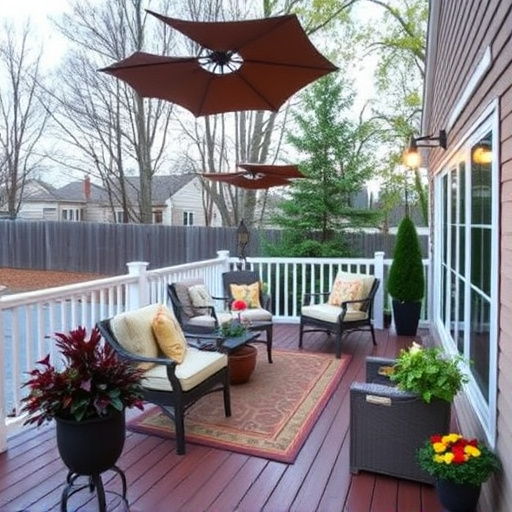
Ground level deck options balance aesthetics and functionality. Wood offers natural beauty but requi…….
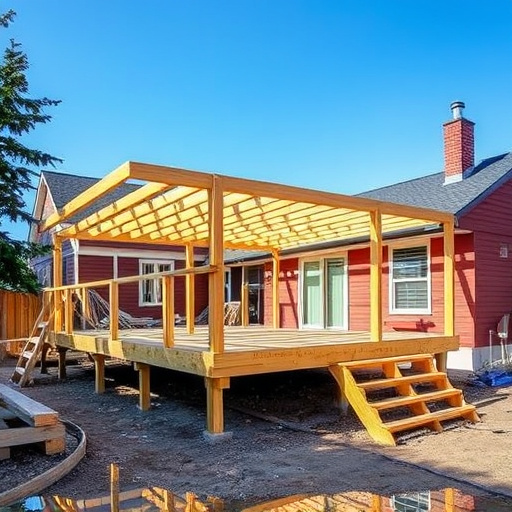
Sweep and clean a ground level deck to remove debris and stains. Regularly inspect for damage, use a…….
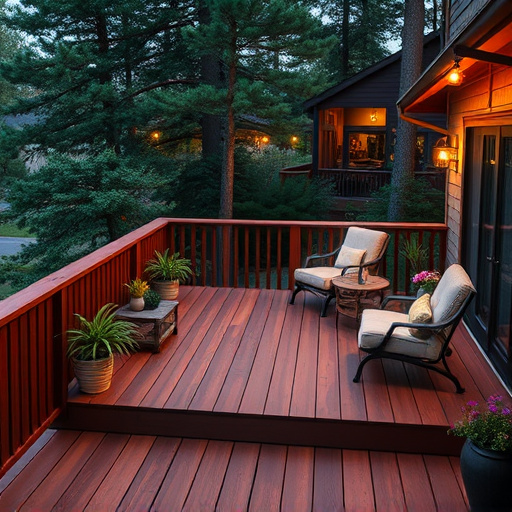
Designing a ground level deck? Embrace sustainability by aligning aesthetics with local ecosystem, u…….
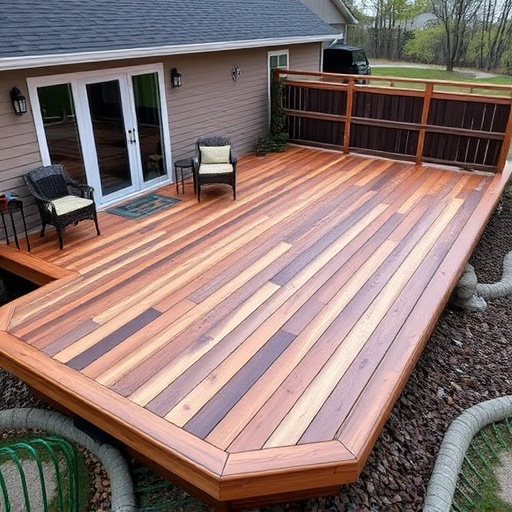
When planning a ground level deck, homeowners should consider property layout, natural elements, int…….
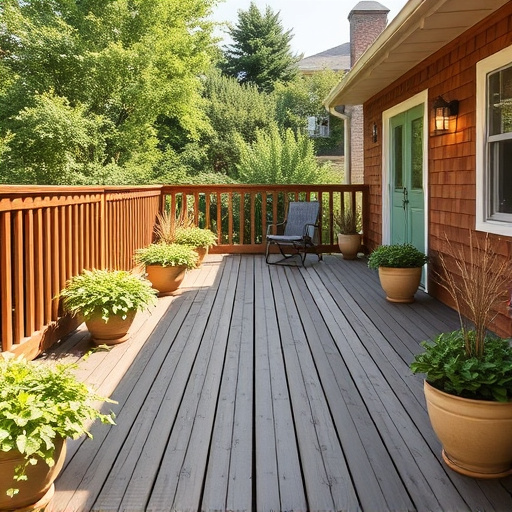
Designing a ground level deck requires selecting complementary materials that match surrounding text…….
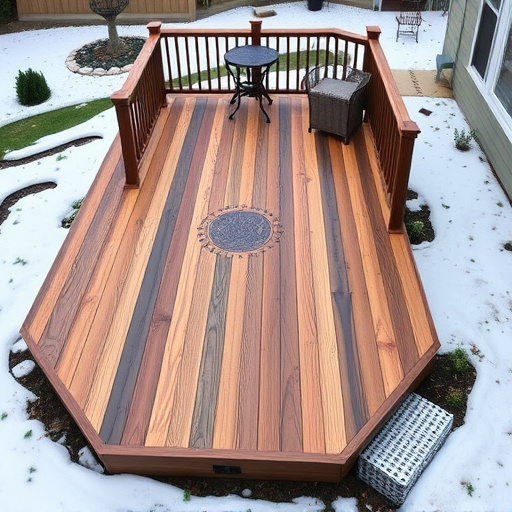
Regular inspections (at least twice a year) and prompt repairs prevent damage from weather, foot tra…….
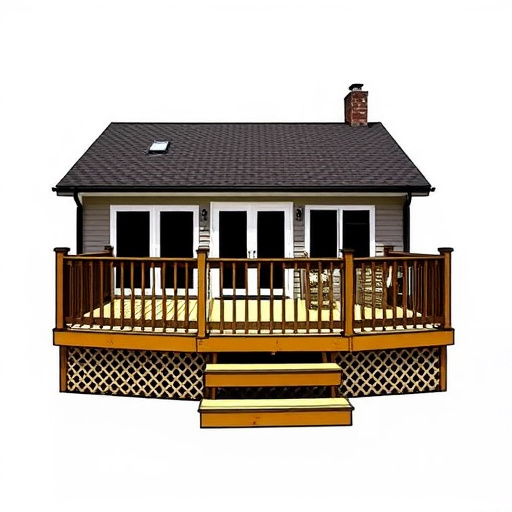
Ground level decks, connecting outdoor spaces, benefit from strategic material choices: treated wood…….